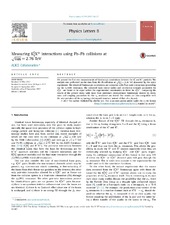Measuring K\(^0_{\rm S}\)K\(^{\rm \pm}\) interactions using Pb-Pb collisions at \({\sqrt{s_{\rm NN}}=2.76}\) TeV
Acharya, Shreyasi; Adamová, Dagmar; Adolfsson, Jonatan; Aggarwal, Madan M.; Aglieri Rinella, Gianluca; Agnello, Michelangelo; Agrawal, Nikita; Ahammed, Zubayer; Ahmad, Shafiq F.; Ahn, Sang Un; Alme, Johan; Altenkaemper, Lucas; Djuvsland, Øystein; Lønne, Per-Ivar; Nystrand, Joakim; Rehman, Attiq ur; Røhrich, Dieter; Tambave, Ganesh Jagannath; Ullaland, Kjetil; Velure, Arild; Wagner, Boris; Zhang, Hui; Zhou, Zhuo; Zhu, Hongsheng; Arsene, Ionut Christian; Bätzing, Paul Christoph; Dordic, Olja; Lardeux, Antoine Xavier; Lindal, Svein; Mahmood, Sohail Musa; Milosevic, Jovan; Richter, Matthias Rudolph; Røed, Ketil; Skaali, Toralf Bernhard; Tveter, Trine Spedstad; Wikne, Jon Christopher; Zhao, Chengxin; Helstrup, Håvard; Hetland, Kristin Fanebust; Kileng, Bjarte; Nesbø, Simon Voigt; Langøy, Rune; Lien, Jørgen André; Aiola, Salvatore; Akindinov, Alexander; Alam, Sk Noor; Alba, José Luis Bazo; De Albuquerque, Danilo Silva; Aleksandrov, Dimitry; Alessandro, Bruno; ALICE, Collaboration
Peer reviewed, Journal article
Published version

Åpne
Permanent lenke
https://hdl.handle.net/1956/18189Utgivelsesdato
2017-11Metadata
Vis full innførselSamlinger
Originalversjon
https://doi.org/10.1016/j.physletb.2017.09.009Sammendrag
We present the first ever measurements of femtoscopic correlations between the K\(^0_{\rm S}\) and K\(^{\rm \pm}\) particles. The analysis was performed on the data from Pb-Pb collisions at \(\sqrt{s_{\rm NN}}=2.76\) TeV measured by the ALICE experiment. The observed femtoscopic correlations are consistent with final-state interactions proceeding via the \(a_0(980)\) resonance. The extracted kaon source radius and correlation strength parameters for K\(^0_{\rm S}\)K\(^{\rm -}\) are found to be equal within the experimental uncertainties to those for K\(^0_{\rm S}\)K\(^{\rm +}\), Comparing the results of the present study with those from published identical-kaon femtoscopic studies by ALICE, mass and coupling parameters for the \(a_0\) resonance are constrained. Our results are also compatible with the interpretation of the \(a_0\) having a tetraquark structure over that of a diquark.
